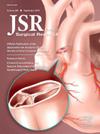Effects of Different Treatment Modalities on Lung Injury in Experimental Pulmonary Contusion Model
IF 1.8
3区 医学
Q2 SURGERY
引用次数: 0
Abstract
Introduction
The study experimentally evaluated the efficacies of different agents in treating pulmonary contusion.
Methods
In our study, 42 Wistar albino rats were divided into six groups of seven animals each. A model of lung contusion with blunt chest trauma was performed in five groups, except for the control group. One group with pulmonary contusion was considered an untreated group, and saline was administered. For other groups, prednisolone, tranexamic acid, N-acetylcysteine, and vitamin E were applied to determine their efficacy in treatment. The rats were sacrificed 24 h after trauma, and their injured lungs were collected for histopathological examination and blood samples for blood gas analysis. Histopathologically, bronchial damage, alveolar hemorrhage, emphysema, and leukocyte infiltration were assessed using the scoring system.
Results
In our study, statistically significant differences were detected between the rat groups in terms of intraalveolar hemorrhage, leukocyte infiltration, and bronchial damage. In post hoc analysis, intraalveolar hemorrhage was significantly higher in the untreated group compared to the control group (P = 0.012). A near-significant difference was observed between the untreated group and the N-acetylcysteine group (P = 0.061). Regarding leukocyte infiltration, the tranexamic acid group showed significantly higher values compared to both the prednisolone and control groups (P = 0.007; P = 0.016, respectively). For bronchial damage, the levels observed in the vitamin E and tranexamic acid groups were significantly higher than those in the control group (P = 0.08 and P = 0.037, respectively).
Conclusions
Many agents are used to treat pulmonary contusion, but no gold standard treatment exists. Prednisolone and N-acetylcysteine play significant roles in treatment. These two drugs contributed to the regression of the findings in pulmonary contusion treatment.
求助全文
约1分钟内获得全文
求助全文
来源期刊
CiteScore
3.90
自引率
4.50%
发文量
627
审稿时长
138 days
期刊介绍:
The Journal of Surgical Research: Clinical and Laboratory Investigation publishes original articles concerned with clinical and laboratory investigations relevant to surgical practice and teaching. The journal emphasizes reports of clinical investigations or fundamental research bearing directly on surgical management that will be of general interest to a broad range of surgeons and surgical researchers. The articles presented need not have been the products of surgeons or of surgical laboratories.
The Journal of Surgical Research also features review articles and special articles relating to educational, research, or social issues of interest to the academic surgical community.

 求助内容:
求助内容: 应助结果提醒方式:
应助结果提醒方式:


